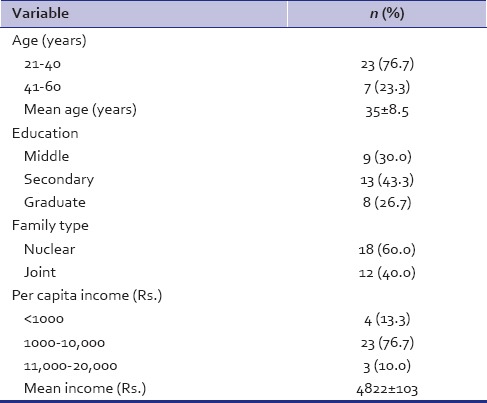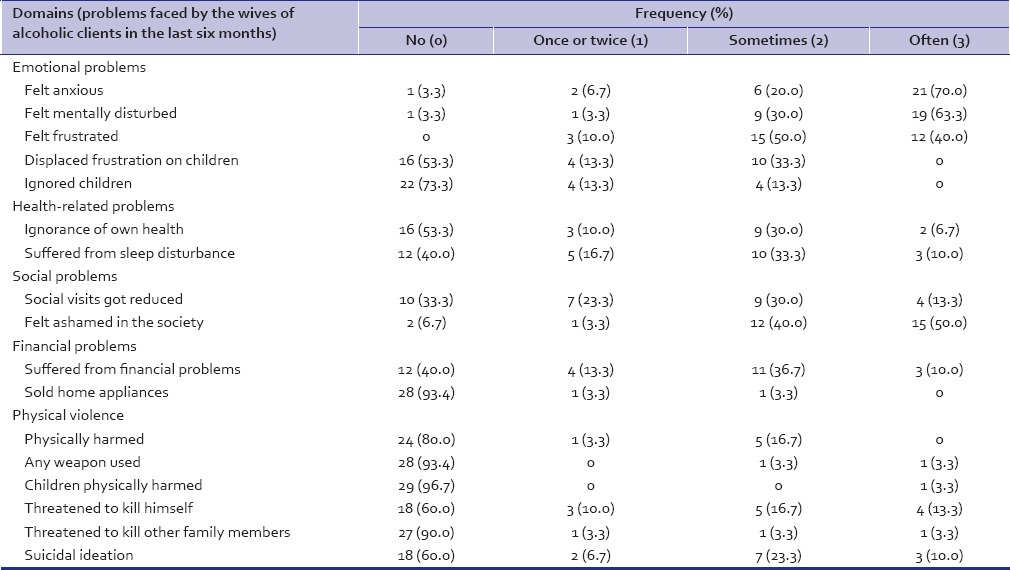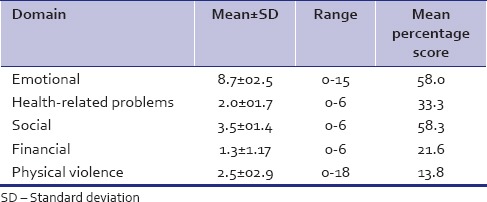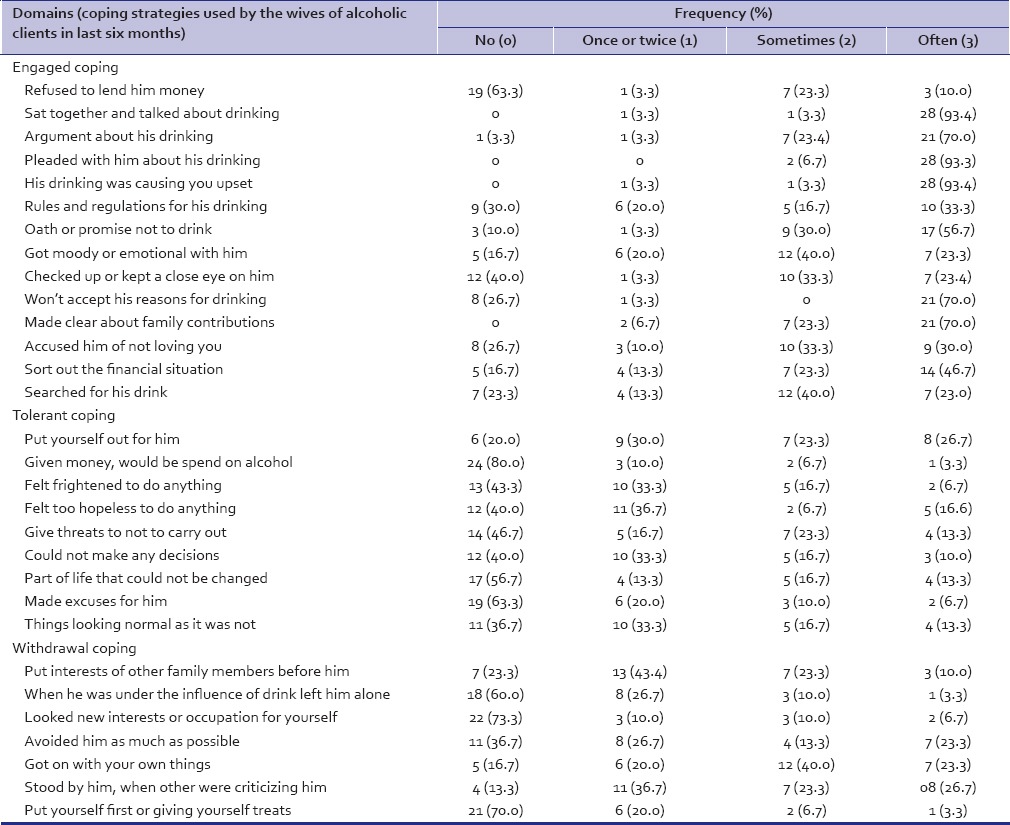Abstract
Background:
Alcoholism is considered as a major health as well as a social problem. Often the family members of alcoholics suffer intense psychological, physical and social trauma due to the core drinking problem of the family member. Most deeply affected are the wives of alcoholics.
Aim:
The present descriptive study aimed to investigate the problems faced and coping strategies used by the wives of alcoholics.
Methodology:
A total of 30 wives of alcoholic clients seeking treatment in De-addiction Centre were interviewed for the same. The problems were identified using a non standardized 17 item structured questionnaire while coping in wives of alcoholics was assessed using standardized tool.
Results:
The findings revealed the problems faced by alcoholics wives were in multiple domains viz. physical, psychological and social. While most highly reported were the emotional problems and least reported were the problems of physical violence. Coping strategies used by wives of alcoholics were reported in three major styles: engaged, tolerant and withdrawal.
Conclusion and Recommendations:
The problems faced by alcoholics have often wedged the attention in society yet finding and applying effective interventions to reduce the pain and suffering of being a partner of alcoholic is still a challenge.
Keywords: Alcohol, coping, wives
Alcoholism is considered as a major health as well as a social problem. It generally refers to an uncontrolled consumption of alcoholic beverages to such an extent that it turns out detrimental to the drinker's health, the personal relationships, and overall social functioning. As per the “alcohol alliance policy,” it is estimated that there are around 62.5 million alcohol users in India. The consumption rates of alcohol are so high in India, that it has been identified as the third largest market for alcoholic beverages in the world.[1] The problem of alcoholism though defined in context of an individual affects the family as a whole. When one member of the family abuses alcohol, it causes disruption and disharmony within the family and thus, every member suffers. The impact of alcoholism on the family is so marked that it leads to the absolute breakdown of family as an entity. The family members of alcoholics often report various negative emotional states ranging from guilt, shame, anger, fear, grief, and isolation. Among all members, the wives of alcoholics are most adversely affected. The wives of alcoholics undergo intense trauma and stress in their domestic environment which brings about major psychological problems in them. The high levels of anxiety, depression, neuroticism, and poor self-esteem are a few in the slope. Domestic violence, emotional violence, and financial violence are some of the frequently occurring and well-recognized problem faced by wives of alcoholics.[2] Moreover, the alcoholic is so obsessed with drinking that he ignores the needs and situations of other family members and is unable to take up his expected roles and responsibilities. In such scenario, the functions which are normally carried by husbands often fall on the wives that further add to their burden and suffering.[3]
When there is mental break down, the human being grasps at ways of coping with crisis and so does the wives of alcoholics. Coping strategies' used by the wives of alcoholics are the concerted efforts both behavioral as well as psychological which are employed by them to master, tolerate, reduce, or minimize the stress associated with their husband's drinking. Traditionally, such coping is thought to involve two major focuses: emotion-focused and/or problem focused. The problem focused coping involves some active action to alleviate stressful circumstances, and the emotion-focused coping involves the efforts to regulate the emotional consequences of stressful events. The coping processes were long back studied by Jackson in 1954, who, outlined seven successive stages of family adjustment to alcoholism which voyages from denial of the problem to disorganization to escape and last the reorganization.[4] Oxford and Gutherie conducted an empirical investigation on coping behavior of wives of alcoholics to reveal five interpretable components which they labeled attack, withdrawal, protection, acting out, and safeguarding family interests.[4] There are studies exploring the coping styles used by the wives of alcoholic clients. Some of such studies have specifically focused on the determinants of coping styles used. Most of these studies are conducted in 80's. It is expected that with rapid urbanization and changes in social structure, the changes are expected in behavioral processes such as coping, especially in females of a rapidly molding community of India. The current study aimed to assess the problems faced by wives of alcoholic clients and the coping strategies used by them.
MATERIALS AND METHODS
Research design
A descriptive research design was employed in the present study to assess the problems faced by wives of alcoholics and coping strategies employed by them.
Sample
A total of thirty alcoholic clients' wives who accompanied their husbands' who were seeking treatment in De-addiction and Treatment Center OPD, PGIMER, a tertiary care hospital in North India were enrolled for the study. The sample was chosen using total enumeration technique wherein all the wives who accompanied their husband's during the data collection period and fulfilled the inclusion criteria were selected. The following inclusion criteria were used: The wives of alcoholics visiting DDTC OPD with their husband and staying with the alcohol abusing husband for at least past 6 months. The wives of the clients who abused any other psychoactive substance or multidrug users were not included in the study.
Tools
The following research tools were used in the study:
Socio demographic profile sheet
It comprised items including the age, gender, educational status, occupational status, and other demographic information of wives of alcoholic clients.
Problems of wife of alcoholic questionnaire
It is a 17-item structured questionnaire prepared by the researcher after intensive review on problems faced by the wives of alcoholics. The face validity of the tool was done by the experts in the field of nursing, psychiatry, and psychology. The problems faced were categorized into five major domains: emotional, financial, social, physical, and health related. Each item of the questionnaire was to be responded by choosing appropriate option from a four-point scale ranging from 0 to 3 where 0 corresponded never, 1 corresponded as once or twice, 2 was sometimes, and 3 referred to often. The questionnaire yield scores in terms of problems in five domains, which was obtained by summing individual item scores in each domain.
Questionnaire of coping strategies used by wives of alcoholic clients
It is a standardized tool developed by Oxford et al (1976).[4] There are totally 30 items in the scale. Each item is rated on a four-point scale ranging from 0 to 3. The tool yields mean scores in three forms of coping, namely, engaged coping, tolerant coping, and withdrawal coping. Engaged coping is coping by standing up to the problem (14 items), tolerant coping is inactive coping by putting up with the problem (9 items), and withdrawal coping is withdrawing from the problem and gaining independence (7 questions). The mean scores can be obtained by simply summing up the individual items score on each subscale. The tool was translated into Hindi and retranslated into English after seeking validation from language experts.
Procedure
The permission was obtained from all concerned authorities in the beginning. The ethical clearance was obtained from the Ethics Committee of the Institute. Written informed consent was taken from each study subject, and rapport was developed. The data were collected by conducting the individual interview of each study subject using above-mentioned questionnaires. The mean duration of each interview was 30 min.
Data analysis
Being largely a descriptive study, only a bare minimum analysis of the data using the (IBM, SPSS Statistics for Windows, Version 19.0.) was done. Descriptive statistics consisted of frequency counts, percentages, means, and standard deviations.
RESULTS
Table 1 depicts the sociodemographic profile of the study participants. The majority of participants were in the age range of 21–40 years. Almost 43% of participants had education up to secondary level while 26% were educated up to graduate level. With regard to family type, 60% of them belonged to nuclear family. Almost three-fourth of the participants had per capita income between Rs. 1000 and 10,000 with mean per capita income of Rs. 4822.
Table 1.
Sociodemographic profile of study participants

Table 2 depicts the problems faced by the wives of alcoholic clients in terms of frequency distribution of rating done by them. Item no. 1–5 represents the emotional problems. There were 70% wives who often felt anxious owing to the drinking problem of their husbands. More than 60% of wives also reported feeling mentally disturbed often. In addition, 50% of wives felt frustrated sometimes. Despite such emotional problems, almost half of them never displaced their frustration on children and three-fourth of them never ignored their children. Item no. 6–7 depicts the health-related problems. It was seen that only 7% of the wives reported that they often ignored their own physical health while 10% of them also reported sleep disturbances. Item 8–9 display the problems in social domain. There were 13% of wives who reported that their social visits get reduced often owing to their husband's drinking and half of them reported feeling ashamed in society. Item 10–11 depict the financial problems faced by them. Only three participants reported that they often have financial problems related to drinking. With regard to the problems of physical violence, very few wives reported various forms of violence by their alcoholic partner. It was only 3% wives who reported that their alcoholic partner often uses weapon against them and physically harm their children.
Table 2.
Problems faced by wives of alcoholic clients

Table 3 depicts the mean scores, range, and mean percent scores on domains of problems faced by the wives of alcoholics. As shown in Table 3, the mean percent scores were highest in emotional and social domain while lowest in the financial domain.
Table 3.
Mean score, standard deviation, range, and mean% score on domains of problems faced by the wives of alcoholics

Table 4 gives item-wise ratings on each item of scale to assess the coping strategies' used by wives of alcoholics. Item no. 1–14 represent engaged coping, item 15–23 represent tolerant coping, and item 24–30 represent withdrawal coping. Some of the often used engaged coping styles included actions such as sitting together and talking about drinking, which was reported to be used often by 93.4% wives. 93.4% of them also reported that their partners drinking was making them upset often. Another 93% of them used pleading their partners for not drinking as engaged coping style. Arguing is also considered to be another form of engaged coping which was used often by 70% wives. The ratings on the tolerant coping revealed that very few wives of alcoholics often used this coping strategy. It was only 3% of them who often gave money to their alcoholic partner, only 13% of them often considered the problem of alcoholism as a part of life that could not be changed. It was only 6% of them who used tolerant coping to an extent to make excuses for their partner. The third commonly employed coping strategy was that of withdrawal coping. Almost one-fourth of the study wives reported using avoidance as coping strategy while another 23% reported that they tried getting on their own things as their coping mechanism.
Table 4.
Coping strategies used by wives of alcoholics

DISCUSSION
The wives of alcoholic clients are often subjected to various forms of physical, psychological, and emotional problems. The spectrum of problems varies from mild emotional insults to physical violence. The present study highlighted the problems faced by the wives of alcoholics into five major domains: emotional, health related, social, financial, and physical violence. In the present investigation, large number of wives reported anxiety and mental disturbance owing to the drinking problems of their husbands. Anxiety, depression, and poor adjustment are commonly reported problems among the wives of alcoholics in literature. Some other authors have also reported negative emotions such as anger, frustration, desperation, nervousness, fear, guilt, and at times hostility among wives of alcoholic clients. Kuruvilla and Rao, (2004) reported that impact of alcoholism can be so marked on the female partner that she herself start behaving like an addict.[4] Some of the authors have even reported the terms neurotic, psychologically maladjusted, and sadistic in context of wives of alcoholic clients.[5] These negative emotional states further affect the self-esteem, self-concept, meaning in life, quality of life, and overall life satisfaction among them.
The psychological problems faced by the wives of alcoholics often set in motion an array of physical problems as well. Ignoring one's own physical health and sleep disturbances are commonly reported. An empirical investigation supported a high prevalence of psychosomatic disorders among the wives of alcoholic clients as compared to that of nonalcoholics. There are differences in mean number of past illnesses as well as the number of current illnesses. The two most commonly reported psychosomatic problems were that of genital and cardiovascular system.[6]
Social drinking has become far more acceptable in Indian community, but the problem drinking is often viewed as stigmatic. Thus, the family members of alcoholic participants often feel estranged and are looked on by others. In the present study, 50% wives reported feeling ashamed in the society. This leads to marked reduction in the social engagements. The wives of alcoholic clients also report general social dysfunction.[5]
The violence by the alcoholic partner is most commonly reported problem in the wives of alcoholic clients. In initial phases, it often occurs when the client is under the effect of alcohol, and gradually it becomes a conditioned response. Nemeth et al. explored the triggers causing acute violence among women using the telephonic interviews.[7] They found that accusations of infidelity in context of alcohol or drug use were most common trigger. Although in the present study, a substantially small fraction of wives reported being a victim of violence; however, in literature, the prevalence of violence among the wives of alcoholics is high. There are studies reporting violence in distinct domains: physical, emotional, intellectual, and economic.[8]
The problem of alcoholism though looks such as a single unitary area of concern; however, this single problem is so colossal that it somehow percolates each and every aspect of wives of alcoholic clients starting from interpersonal to social and to further intrapersonal realms of their life. Stress becomes an inevitable ingredient of their day-to-day life. In such situation, they are bound to use some conscious or unconscious efforts to minimize its impact on them as well as their children using various forms of coping. The literature gives various forms of active and passive actions on the part of wives of alcoholics which turns out adaptive for them. Denial of the problem, attempt to eliminate the problem, disorganization, attempts to reorganize inspite of problem, efforts to escape the problems, reorganization of part of the family and recovery and reorganization of the whole family are commonly reported.[4] Kuruvilla and Rao viewed coping among wives of alcoholics in ten distinct behavioral actions: Discord, avoidance, indulgence, competition, antidrink assertion, sexual withdrawal, fearful withdrawal, taking special action, and marital breakdown.[4] In the present study, the coping was seen in the three major forms: engaged coping, tolerant coping, and withdrawal coping.
Engaged coping is a form of coping in which the wife of alcoholic gets vigorously engaged with an alcoholic husband through active interaction. She tends to use various assertive, controlling, emotional, and supporting behaviors to change the husband's drinking. She keeps a watch on each and every move of her alcoholic spouse. The engaged coping itself is very tiring and drains the person emotionally; however, this coping serves to maintain the self-esteem and meaning in the life as the wives employing such actions feel as if they are doing something for the welfare of partner, family, and self. The tolerant coping is more or less like self-sacrifice. It is like putting yourself out for him or giving money even if you know they will be spent on alcohol. The adaptive aspect in this coping is that there are minimal arguments. The withdrawal coping involves avoidance of the drinker and active involvement in other self-regulating activities. It is also reported that tolerant coping and withdrawal coping are associated with poor drinking outcomes as well as poor family outcomes with high depression rates among nonalcoholic spouses.[4] In the current study, this specific finding can be inspected in light of two facts:First, the shift from tolerant coping to engaged coping can be due to transition in social structure from dependent, submissive stereotype of female to an independent, autonomous female who is capable of doing for self-ad family. Second, in the current study, all the study participants were the wives of alcoholic clients who were accompanying them for treatment which itself reflects an engagement of their part with relation to drinking.
The coping strategy used is also a function of individual personality along with other situational determinants. The wives with a dependent-personality profile are more likely to employ tolerant and withdrawal coping styles while the ones who are high on self-esteem, assertiveness, resilience, and dominance would employ more of engaged coping. Further, there are reports of association between the demographic variables of wives and coping styles employed. The other situational determinants of coping are the availability of social support and the financial independence. The culture too affects the coping styles. In west, more of withdrawal coping is prevalent as women are more autonomous and have enough community resources to engage self away from the alcoholic partner while in Indian set up, it is either more of engaged or tolerant coping styles. Looking at the traditional Indian society where females are seen as a weak gender, a dependent gender, there is more of tolerant coping. However, with changes in gender roles and growth of feminism, the engaged coping has turned high. Moreover, in Indian society, marital separation owing to drinking problem is still considered more stigmatic than staying in a conflicting discordant relation. The consequences of marital separation for the children are so overestimated that females do all they can to change their partner's drinking problem for the sake of maintaining the marriage. Many a times, in initial few years of problem, they begin with tolerant styles; however, a hope to get things better leads to more of engaged coping. Such styles when employed over years without any positive outcome ultimately compel the wives to engage in withdrawal coping.
CONCLUSION, LIMITATIONS, AND RECOMMENDATIONS
The alcoholism is though identified as a medical problem has large spectrum of psychosocial difficulties for the family members of alcoholics, specially their spouses. The problems faced by the wives of alcoholics range from physical to emotional to social domains. The prevalence of violence in alcoholic wives is an important social problem. The wives of alcoholic clients might employ various coping strategies to curb the ill effects of their partner's drinking. While some strategies have more positive outcomes than others yet individual differences exist.
The present study findings are consistent to the available literature on same; however, the results highlight the role of culture and changing gender implications on their coping styles. The study, however, did not explore the subjective distress and pain the partners of alcoholic clients go through their lives as pure descriptive and cross-sectional assessment were done. The study also did not look into the association between demographic variables and coping styles used.
It is further recommended that such investigation can be taken up in a qualitative manner to subjectively understand and acknowledge the pain of being a wife of an alcoholic. Moreover, longitudinal assessment of coping styles as well their outcomes can be employed. Such evidence can be further utilized in developing training and resilience-building programs for the wives of alcoholic clients.
Financial support and sponsorship
Nil.
Conflicts of interest
There are no conflicts of interest.
REFERENCES
- 1.Alcohol Related Harm in India – A Fact Sheet. Chennai: Global Alcohol Policy Alliance; [Last retrieved on 2015 Mar 30]. Available from: https://www.scribd.com/document/44004911/Alcohol-Related-Harm-in-India-a-Fact-Sheet . [Google Scholar]
- 2.Sekii T, Shimizu S, So T. Drinking and domestic violence: Findings from clinical survey of alcoholics. Jpn J Alcohol Stud Drug Depend. 2005;40:95–104. [PubMed] [Google Scholar]
- 3.Kaur D, Ajinkya S. Psychological impact of adult alcoholism on spouses and children. Med J Dr Patil Univ. 2014;7:124. [Google Scholar]
- 4.Orford J, Gulhric S, Nlcholls P, Oppcnhcimcr E, Egert S, Hensmnn C. Self reported coping behaviours of wives of Alcoholics and its association with drinking outcome. J studies on Alcohol. 1976;36:1254–67. doi: 10.15288/jsa.1975.36.1254. [DOI] [PubMed] [Google Scholar]
- 5.Parsakarathy K. Psychosocial problems of wives of alcoholics. [Last retrieved on 2015 Mar 30];IJSR. 2013 2:574–75. Available from: http://www.theglobaljournals.com/ijsr/file.php?val=May_2013_1367592302_a9f79_197.pdf . [Google Scholar]
- 6.Okazaki N, Fujita S, Suzuki K, Nimmi Y, Mizutani Y, Kohno H. Comparative study of health problems between wives of alcoholics and control wives. Jpn J Alcohol Stud Drug Depend. 1994;29:23–30. [PubMed] [Google Scholar]
- 7.Nemeth JM, Bonomi AE, Lee MA, Ludwin JM. Sexual infidelity as trigger for intimate partner violence. J Womens Health. 2012;21:942–9. doi: 10.1089/jwh.2011.3328. [DOI] [PubMed] [Google Scholar]
- 8.Govindappa L, Pnkajakshi B. A community study on wives of alcoholics. [Last retrieved on 2015 Mar 30];DPS. 2014 17:323–27. Available from: http://www.medind.nic.in/daa/t14/i2/daat14i2p323.pdf . [Google Scholar]


